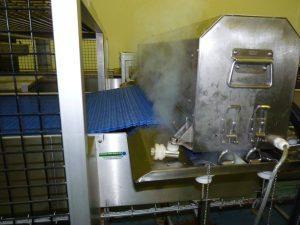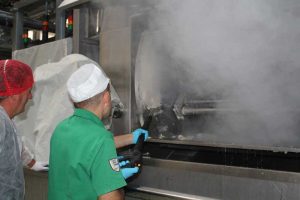Conveyor belt washing systems play a crucial role in maintaining hygiene in various industries, particularly in food processing and pharmaceuticals. These systems are designed to remove contaminants, debris and residues from conveyor belts, ensuring that the products being transported remain free from potential sources of contamination. In industries where hygiene is of paramount importance, such as food processing, the implementation of conveyor belt washing systems is essential to comply with stringent regulations and standards set by food safety authorities.
The cleanliness of conveyor belts is directly linked to the quality and safety of the products being transported. Any accumulation of dirt, bacteria or other contaminants on the conveyor belt can lead to cross-contamination and compromise the integrity of the products. This can result in costly product recalls, damage to brand reputation and, most importantly, pose a risk to consumer health.
Therefore, investing in conveyor belt washing systems is not only a matter of compliance with industry regulations but also a critical step in ensuring the highest standards of hygiene and product safety.
Summary
- Conveyor belt washing systems are crucial for maintaining hygiene in food processing and industrial facilities.
- There are various types of conveyor belt washing systems, including manual, automated, and portable systems.
- Implementing conveyor belt washing systems can lead to improved sanitation, reduced risk of contamination, and compliance with industry regulations.
- When choosing a conveyor belt washing system, factors such as the type of conveyor, cleaning requirements, and budget should be considered.
- Regular maintenance and cleaning procedures are essential for ensuring the effectiveness and longevity of conveyor belt washing systems.
Types of Conveyor Belt Washing Systems
Automated Spray Systems
One common type is the automated spray system, which utilises high-pressure nozzles to deliver a targeted spray of water and cleaning solution onto the conveyor belt. This method is effective in removing stubborn residues and contaminants from the belt surface, ensuring thorough cleaning.
Brush Cleaning Systems
Another type is the brush cleaning system, which employs rotating brushes to scrub the conveyor belt surface, dislodging and removing any debris or contaminants. This method is particularly effective for removing dry or sticky residues that may be difficult to remove with just water and cleaning solution.
Foam Cleaning Systems and Selection Criteria
Additionally, there are foam cleaning systems that apply a layer of foam onto the conveyor belt, allowing the cleaning agents to penetrate and break down any residues before being rinsed off. Each type of conveyor belt washing system has its own advantages and is suitable for different applications. Understanding the specific cleaning requirements of the industry and the nature of the residues to be removed is crucial in selecting the most appropriate system for optimal cleaning results.
Advantages of Implementing Conveyor Belt Washing Systems

The implementation of conveyor belt washing systems offers numerous advantages for industries that rely on conveyor belts for their operations. Firstly, these systems help to maintain a high level of hygiene and cleanliness, reducing the risk of contamination and ensuring the safety and quality of the products being transported. This is particularly important in industries such as food processing, where strict hygiene standards are non-negotiable.
Furthermore, conveyor belt washing systems contribute to improved operational efficiency by reducing downtime for manual cleaning and maintenance. Automated washing systems can be programmed to clean the conveyor belts at regular intervals, ensuring continuous operation without interruptions for cleaning. This not only saves time and labour costs but also minimises the risk of human error in manual cleaning processes.
In addition, implementing conveyor belt washing systems can extend the lifespan of the conveyor belts and other equipment by preventing the build-up of residues that can cause wear and tear. By keeping the belts clean and free from contaminants, maintenance costs are reduced, and the overall lifespan of the equipment is prolonged. Overall, the advantages of implementing conveyor belt washing systems are far-reaching, impacting not only hygiene and product safety but also operational efficiency and cost savings.
Considerations for Choosing the Right Conveyor Belt Washing System
When selecting a conveyor belt washing system, there are several key considerations that need to be taken into account to ensure that the chosen system meets the specific needs and requirements of the industry. Firstly, it is important to assess the type and volume of residues that need to be removed from the conveyor belts. Different cleaning systems are designed to handle different types of residues, so understanding the nature of the contaminants is crucial in choosing the most effective system.
Another consideration is the size and layout of the conveyor system. The chosen washing system should be compatible with the existing conveyor setup and should be able to effectively clean all parts of the conveyor belt, including any curves or inclines. Additionally, factors such as water availability, power supply, and space constraints should also be taken into consideration when choosing a conveyor belt washing system.
Furthermore, it is important to consider the level of automation required for the washing system. While some industries may benefit from fully automated systems that require minimal human intervention, others may prefer semi-automated systems that offer more flexibility and control over the cleaning process. Understanding the specific needs and preferences of the industry is essential in choosing a conveyor belt washing system that aligns with operational requirements.
Maintenance and Cleaning Procedures for Conveyor Belt Washing Systems
Proper maintenance and cleaning procedures are essential for ensuring the optimal performance and longevity of conveyor belt washing systems. Regular inspection and cleaning of nozzles, brushes, or other components are necessary to prevent clogging and ensure consistent cleaning results. Any build-up of debris or residues on these components can compromise the effectiveness of the washing system.
In addition, it is important to use the appropriate cleaning agents and sanitizers in accordance with industry regulations and guidelines. Regularly monitoring and adjusting the concentration of cleaning solutions ensures that the conveyor belts are thoroughly cleaned without leaving any harmful residues that could contaminate products. Furthermore, conducting routine checks on the overall condition of the washing system, including pumps, motors, and control panels, is crucial for identifying any potential issues or malfunctions.
Timely maintenance and repairs can prevent costly downtime and ensure that the washing system operates at peak efficiency. Overall, implementing a comprehensive maintenance schedule and adhering to proper cleaning procedures are essential for maximising the effectiveness and longevity of conveyor belt washing systems.
Case Studies: Successful Implementation of Conveyor Belt Washing Systems

Subtitle 1: Food Processing
Several case studies have demonstrated the successful implementation of conveyor belt washing systems across various industries. In a large-scale food processing plant, the implementation of an automated spray system resulted in significant improvements in hygiene and operational efficiency. The system was able to effectively remove stubborn residues from conveyor belts, reducing the risk of cross-contamination and ensuring compliance with food safety regulations.
Subtitle 2: Pharmaceutical Industry
In a case study within the pharmaceutical industry, a brush cleaning system was implemented to clean conveyor belts used for transporting sensitive medical products. The system’s ability to remove both dry and sticky residues without causing damage to the delicate products was crucial in maintaining product integrity and complying with stringent hygiene standards.
Subtitle 3: Manufacturing
In a manufacturing facility that produces automotive parts, a foam cleaning system was installed to clean conveyor belts used in various production processes. The system’s ability to remove oil, grease, and other contaminants from the belts contributed to improved product quality and reducing maintenance costs associated with equipment wear.
These case studies highlight the diverse applications and benefits of implementing conveyor belt washing systems across different industries, showcasing their effectiveness in maintaining hygiene, improving operational efficiency, and ensuring compliance with industry regulations. Future Trends in Conveyor Belt Washing Systems for Improved Hygiene
The future of conveyor belt washing systems is poised for advancements that will further enhance hygiene standards and operational efficiency across industries. One emerging trend is the integration of advanced sensors and monitoring technology into washing systems, allowing for real-time detection of contaminants on conveyor belts. This enables proactive cleaning measures to be taken before any potential risks arise, further reducing the likelihood of product contamination.
Additionally, there is a growing focus on sustainability in conveyor belt washing systems, with an emphasis on reducing water consumption and environmental impact. The development of water-efficient cleaning methods and eco-friendly cleaning agents reflects an industry-wide commitment to sustainable practices while maintaining high standards of hygiene. Furthermore, advancements in automation technology are driving the development of fully integrated conveyor belt washing systems that can be seamlessly integrated into existing production lines.
These advanced systems offer greater flexibility, control, and efficiency in maintaining hygiene standards while minimising operational disruptions. In conclusion, conveyor belt washing systems play a critical role in maintaining hygiene and product safety across various industries. The selection of an appropriate washing system tailored to specific industry needs is essential for achieving optimal cleaning results.
With proper maintenance and adherence to cleaning procedures, these systems can contribute to improved operational efficiency while ensuring compliance with industry regulations. As future trends continue to drive advancements in conveyor belt washing systems, industries can look forward to even higher standards of hygiene and sustainability in their operations.
FAQs
What are conveyor belt washing systems?
Conveyor belt washing systems are designed to clean and sanitize conveyor belts in food processing and manufacturing facilities. These systems use water, detergent, and mechanical scrubbing to remove debris, bacteria, and other contaminants from the conveyor belt surface.
Why are conveyor belt washing systems important for improved hygiene?
Conveyor belt washing systems are important for improved hygiene in food processing facilities because they help to remove food residues, bacteria, and other contaminants from the conveyor belt surface. This reduces the risk of cross-contamination and helps to maintain a clean and hygienic production environment.
What are the benefits of using conveyor belt washing systems?
The benefits of using conveyor belt washing systems include improved food safety, reduced risk of cross-contamination, compliance with hygiene regulations, and increased operational efficiency. These systems also help to extend the lifespan of conveyor belts by preventing the build-up of debris and contaminants.
How do conveyor belt washing systems work?
Conveyor belt washing systems typically use a combination of water, detergent, and mechanical scrubbing to clean the conveyor belt surface. The system may include spray nozzles, brushes, and a recirculating water system to effectively remove debris and contaminants from the belt.
What factors should be considered when choosing a conveyor belt washing system?
When choosing a conveyor belt washing system, factors to consider include the type and size of the conveyor belt, the level of contamination, the required cleaning frequency, water and energy efficiency, and compliance with industry hygiene standards. It is also important to consider the ease of maintenance and the overall cost of ownership.










